Digital Stone Exhibition
Doland Museum of Modern Art, Shanghai, China
The world’s center of gravity has been tilting eastward lately, and the digital art movement reflects that with this ambitious exhibition, in three Chinese venues, sponsored by design software powerhouse Autodesk, whose CEO, Carl Bass, appreciates the challenge posed by artists using computers in unusual ways. The Beijing show, at the Today Art Museum, ended in October, but I got to Shanghai in time for the November 6 opening at the Doland Museum of Modern Art, on Duolun Road in Shanghai. This little street with its increasingly rare old low-rise buildings is quiet for that bustling city, due to a prohibition on (most) 4-wheeled traffic, and large granite pieces by the show’s four featured participants—Bruce Beasley, Jon Isherwood, Kenneth Snelson, Robert Michael Smith—were displayed prominently along it, where passersby ranging from dog-walkers to wedding parties and fashionistas felt free to engage with them. These sculptors had been given the opportunity to produce large scale stone pieces in China, based on digitally-mastered maquettes produced on a smaller scale with 3D printers. These were sent to a stone-carving factory in Southern China and “pointed up” (enlarged) by traditional hand methods. (While it’s also possible to carve stone with specialized computer-controlled milling machines, it turns out to be a lot more expensive, while the Chinese stonecarvers did an amazingly good job of interpreting these unfamiliar abstract forms.)
Bruce Beasley
All four artists rose admirably to the challenge, producing pieces that translated well from small plastic parts to large stone ones—something that’s not as easy to do as it might seem. Beasley, a technically-adventurous artist who has been using computers to design sculpture since the ’eighties, chose to work with a restricted set of basic forms, in this case slightly lentoid disk shapes and bent tubular elements, using the computer to arrive at exactly the right combination of shapes by trial and error, eliminating the work of producing mock-ups in physical materials. Here’s an article I wrote about Beasley’s 2005 retrospective at the Oakland Museum of California.
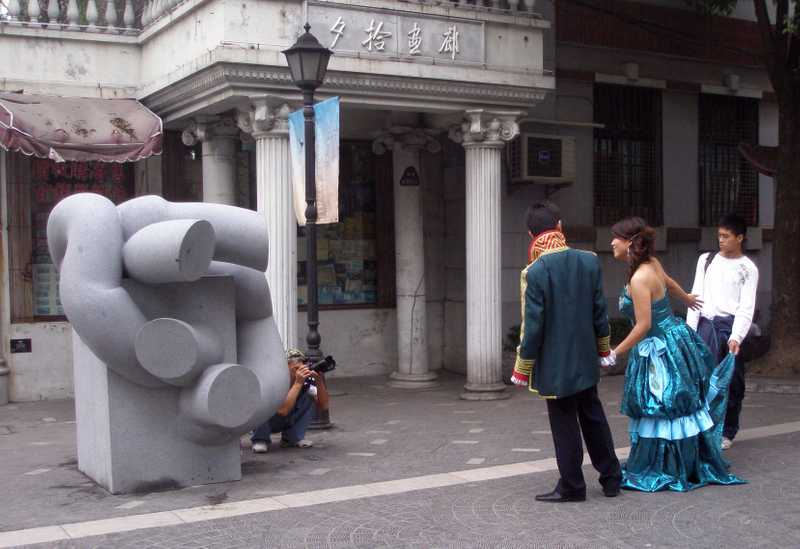
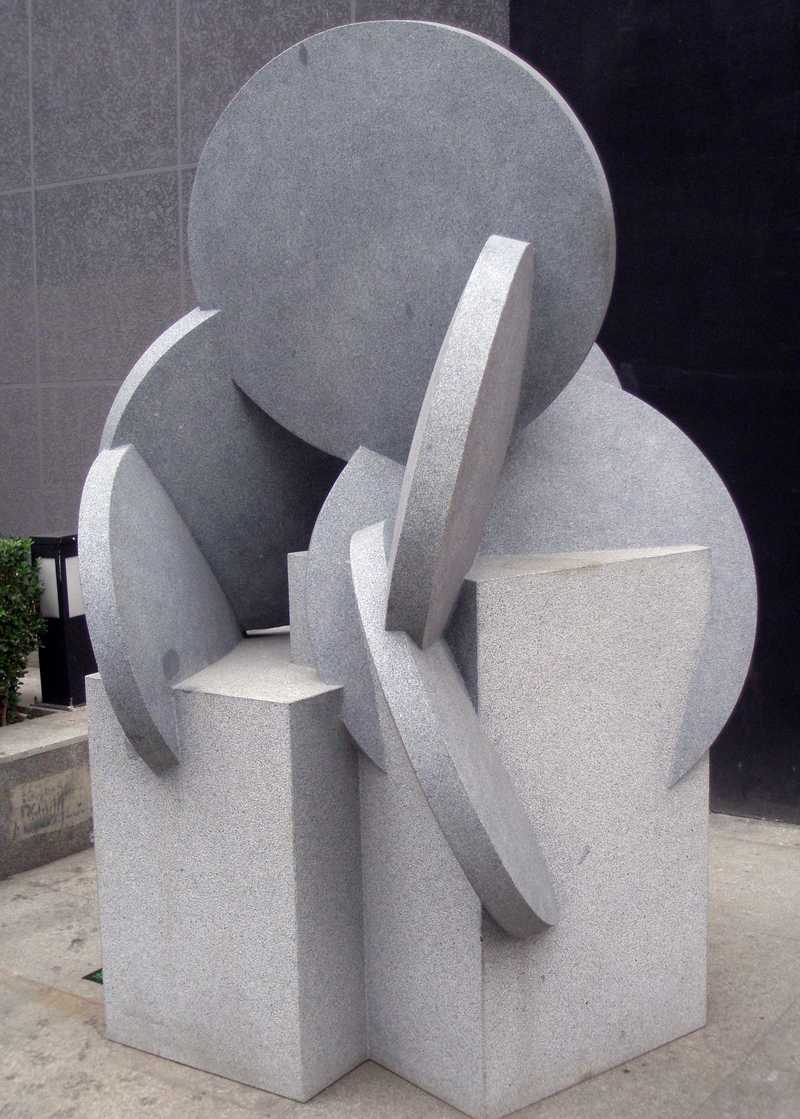
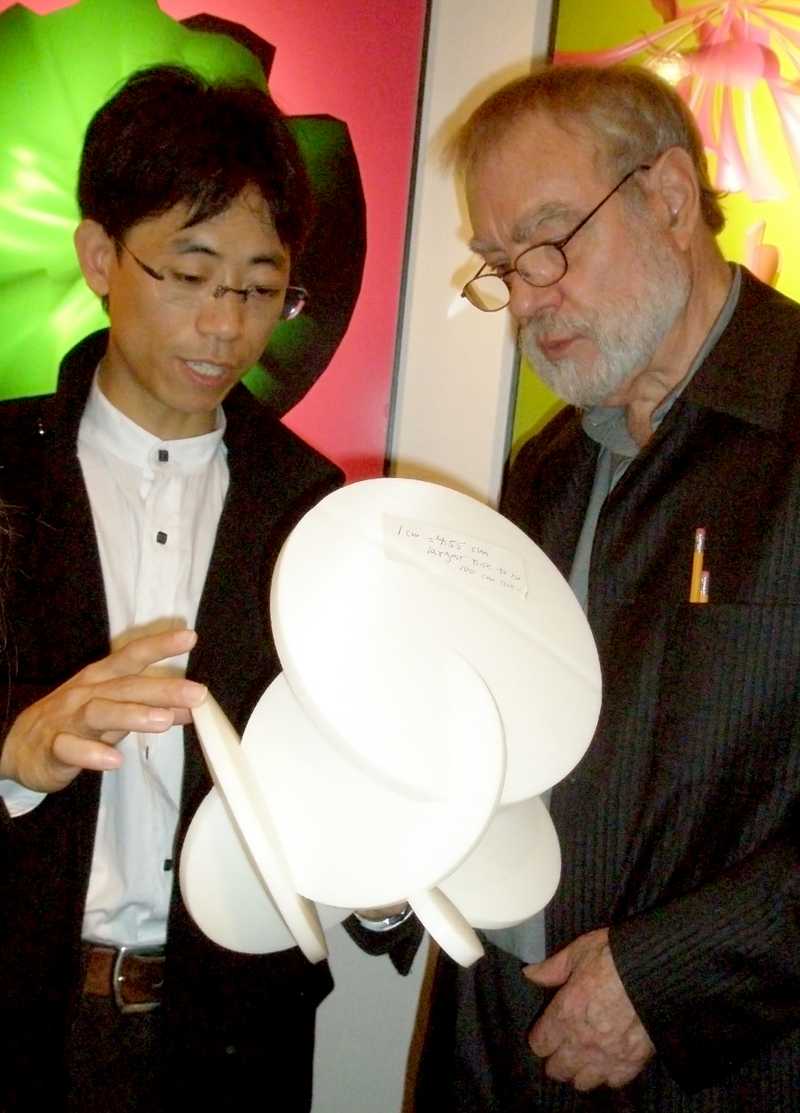
Ken Snelson
Ken Snelson, who is mostly known for his “tensegrity” structures, which use tensioned cable to float structural steel members in seemingly impossible fashion, drew upon his deep meditations on atomic structure to produce a remarkably different series where weightiness is as important an element as is the weightlessness of his previous work. They also play upon a familiar Chinese sculptural trope (originally imported from Europe): the “mystery balls” nesting carved balls within balls, although in Snelson’s interpretation the concentric spheres are not cut free of each other.
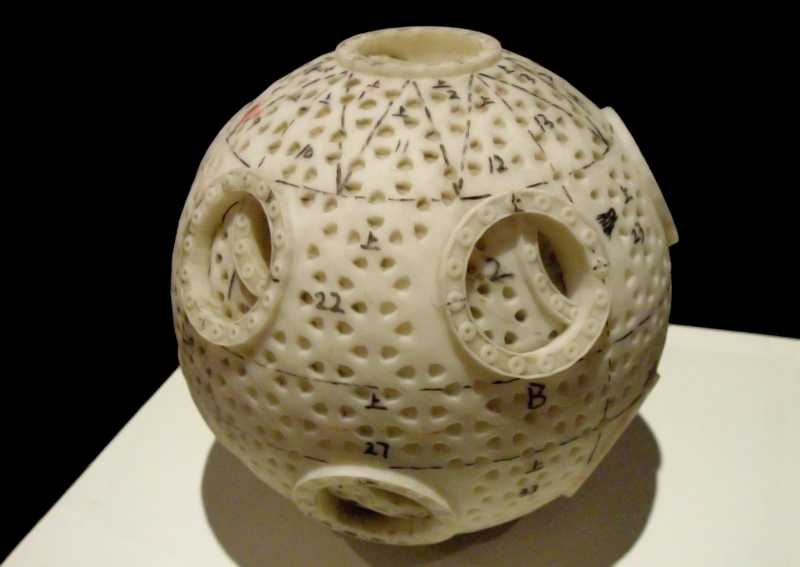

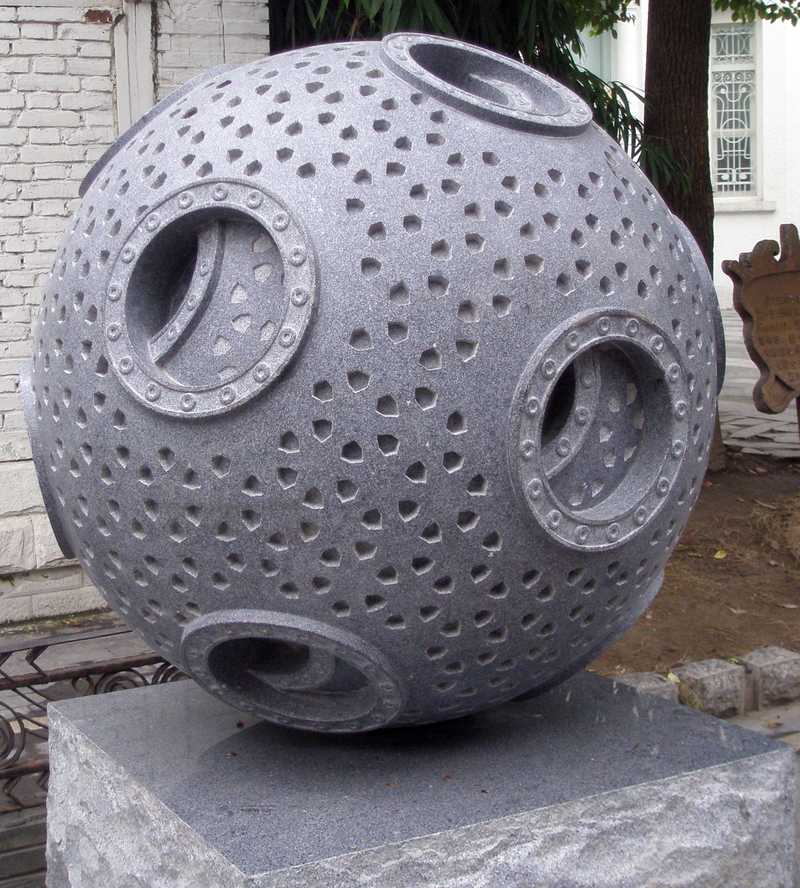
Works by Ken Snelson
Jon Isherwood
Jon Isherwood’s stone pieces were the most diverse of the lot, playfully combining stripes and scales, with gently rippled surfaces intersecting more deeply carved and patterned ones, or erupting as bulbous protrusions. More than the other sculptors in the group, he experimented with various different stones and surface finishes including polish, which brings out the color in the material much more strongly than leaving the surface matte. This let him use the contrast between matte and polished areas effectively, as with the bottle-shaped component in “Tellers of Tales.”

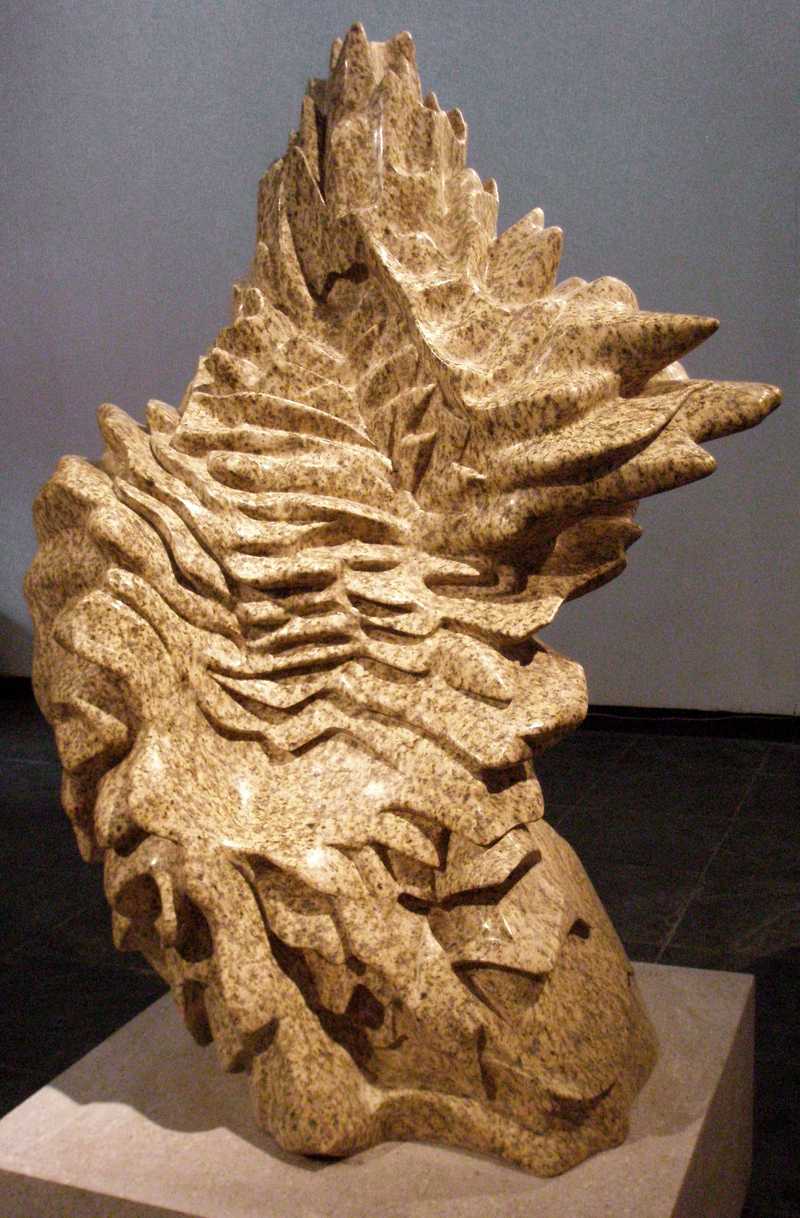
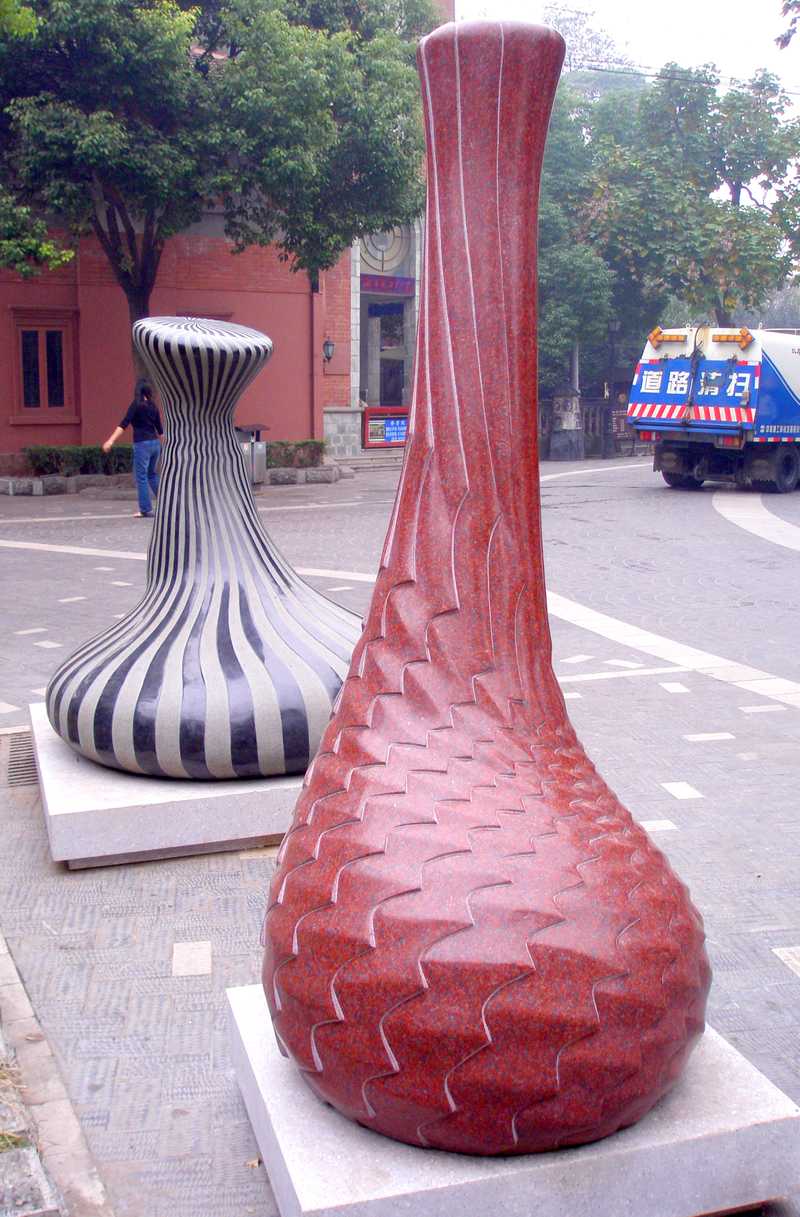
Works by Jon Isherwood
Robert Michael Smith
Smith’s “Quantum Sleep” (partial)
Of the four featured sculptors, the work of Robert Michael Smith comes closest to my own aesthetic preoccupations, although he interprets natural forms abstractly where I use them directly. So while no particular natural objects are actually identifiable in his work, it has an organic quality that both unifies it and sets it apart from culturally-based art, giving it a timeless quality that doesn’t rely on a social context to communicate its deeply-rooted beauty. A master of interpenetrated forms, his pieces often resemble a frozen sequence of unfolding motions—budding, growing, segmenting, or dancing—as captured by a stroboscopic 3D camera. Not surprisingly, he is also an animator, which allows his objects to shed the fixed aspect, to move and metamorphose like the subjects of an alien nature documentary.
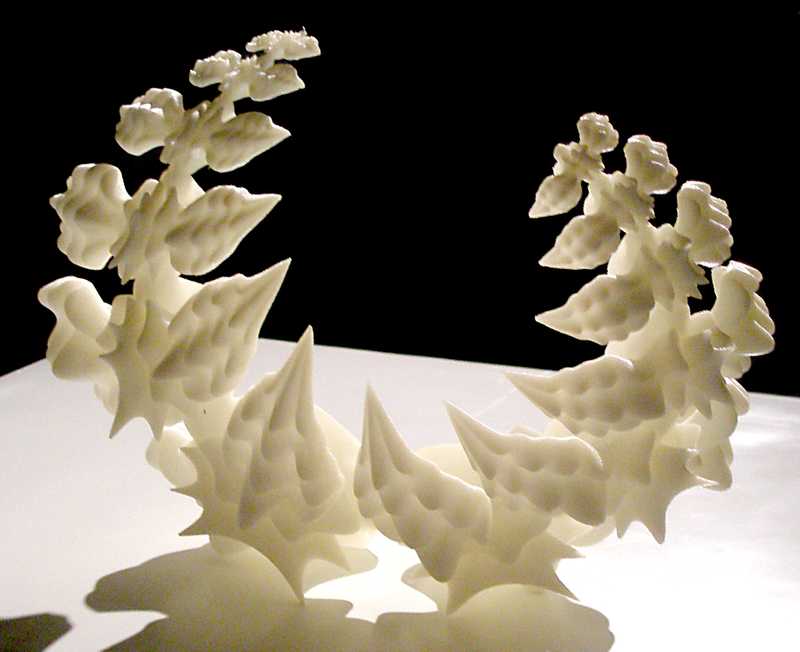

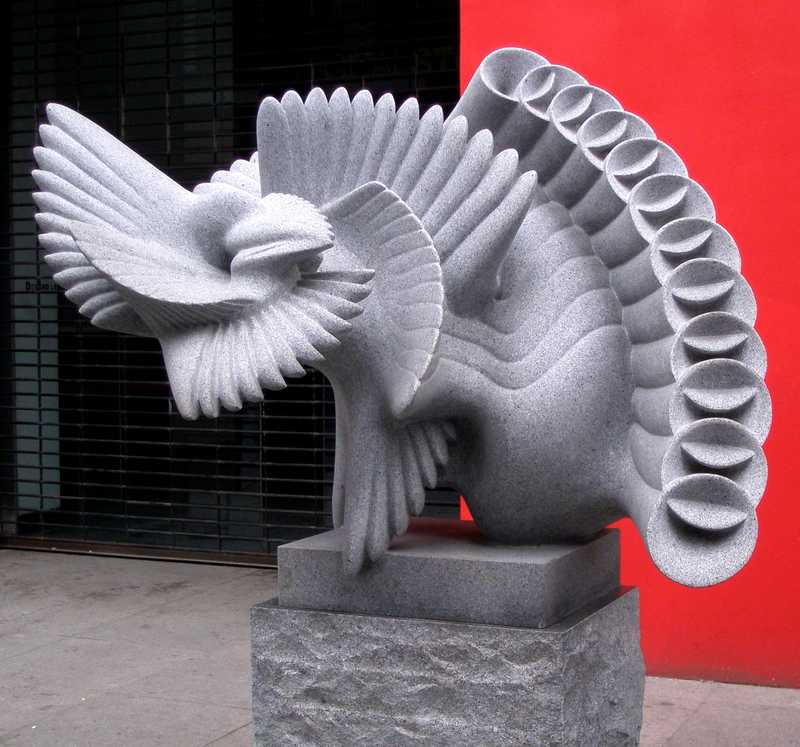
Works by Robert Michael Smith
Jesse Small
The scaled-up stone works also filled the bottom floor of the Doland Museum, a Bauhaus-style building that somehow manages to coexist happily with the traditional architecture that surrounds it. On the floor above was the “e-form” part of the show; a collection of digitally-mediated sculpture, animations, and graphics by a fairly large group of international artists. Some of them were familiar to me from the Intersculpt shows in France (see blog post) but others were new, like Jesse Small, who, since he lives part-time in China in order to take advantage of its facilities for having things made cheaply there in plastic, porcelain, and other materials, was able to attend the opening. He contributed hanging pieces loosely based on Chinese lanterns, with a plasma-cut steel structure at the core supporting injection-molded modular plastic components in the popular “lucky” red color. This modularity made it possible for him to construct a site-specific installation around a spiral stairwell, linking the transparent plastic elements into larger units which partially screened the space but let festive red light through.
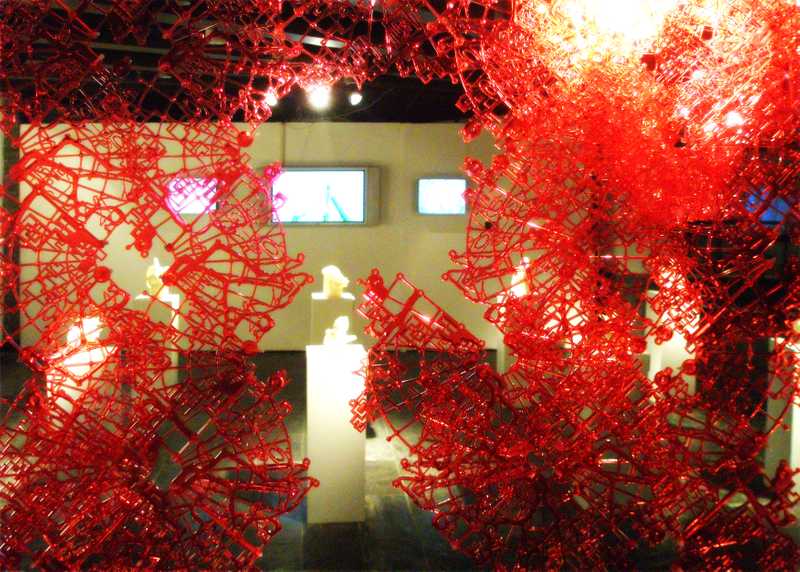
Mary Bates Neubauer, Paul Higham, Elona Van Gent
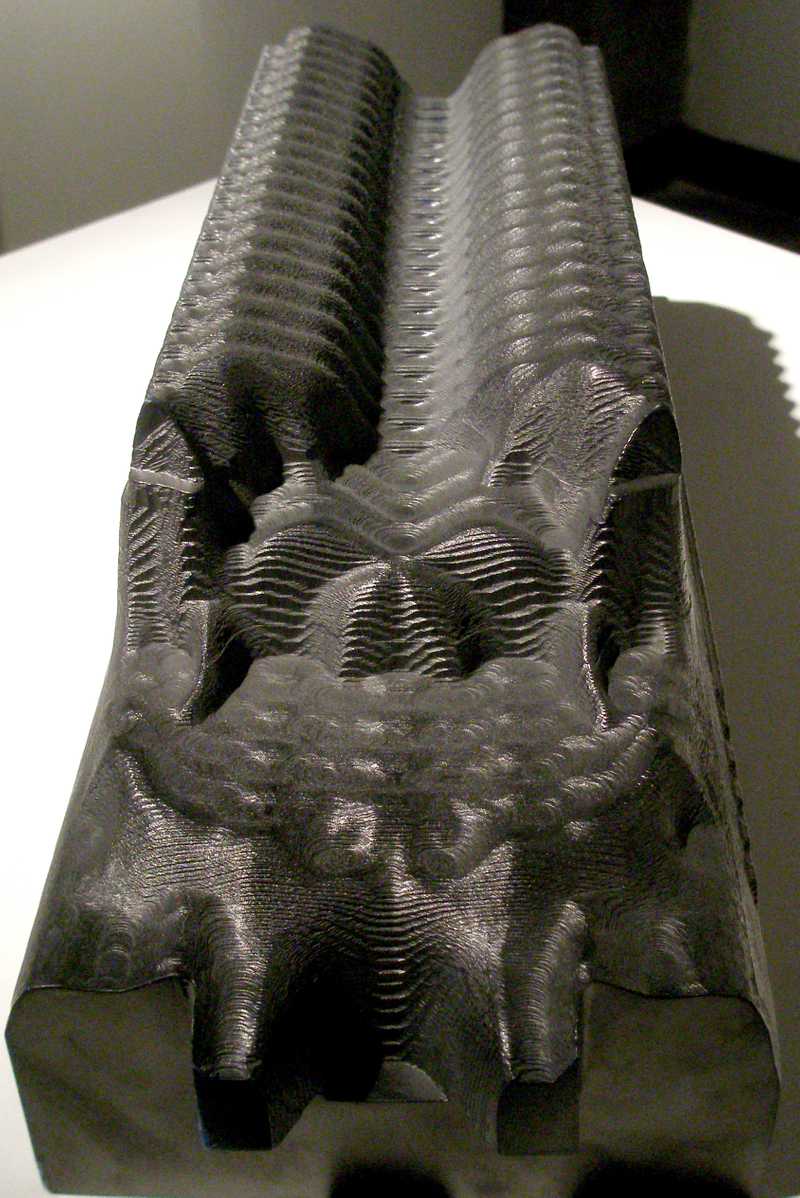
A couple of the artists, Mary Bates Neubauer and Paul Higham, used complex datasets like stock market dividend and hog futures yields, or wave readings from the Tsunami of 2005 as inputs for creating digital sculpture and graphics, resulting in some surprisingly simple and elegant forms and images. I’m not sure how much interpretation goes into making art this way, but Neubauer’s results tended to be delicate and flowerlike, which Higham’s were more massive and mechanical-looking.
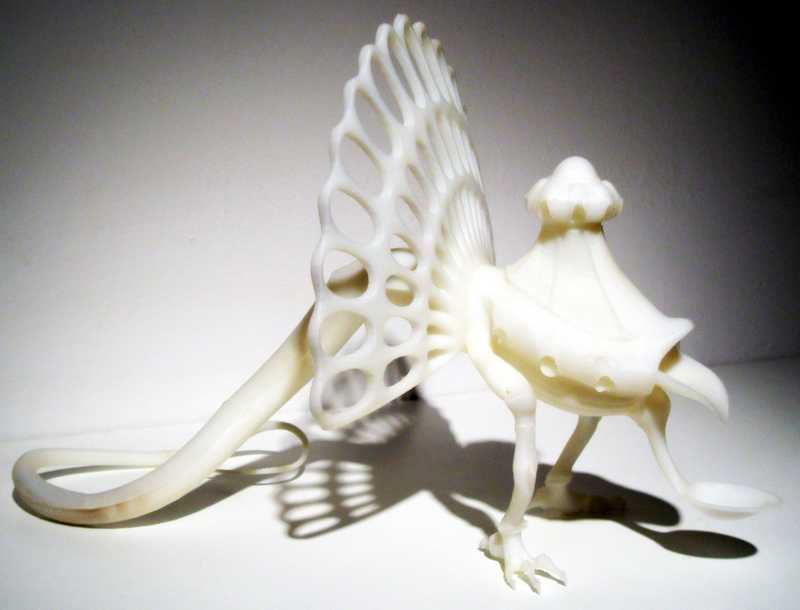
Elona Van Gent took another approach, using high-tech tools to produce a creature that might have stepped out of the work of her fellow-Netherlander, the medieval master painter Hieronymus Bosch. (Navigating her site’s a little tricky; you have to click various parts of the pictured pair of pants to get to the unipod, duopod, tripod, quadropod and n-pod categories into which she divides her work.)
Christian Lavigne, Mary Visser, Michael Rees, Dan Collins, Keith Brown
Of the people I knew already, Christian Lavigne contributed something different from anything I’d seen him do before—a fantasy landscape with mountains, bridges, and the figures of horses. I thought it worked quite well in the white plastic build material used by the Dimension 3D printer (the use of which was contributed by one of the show’s sponsors) that built many of the works in show. By way of contrast, Mary Visser continues to develop themes she’s been working with for some time—the use of repeating and rearranged human figures as abstract elements in assemblage—but the new pieces she sent to China show major progress in refining the already-impressive colored and coated surfaces that make her work stand out in the mostly monochrome crowd.
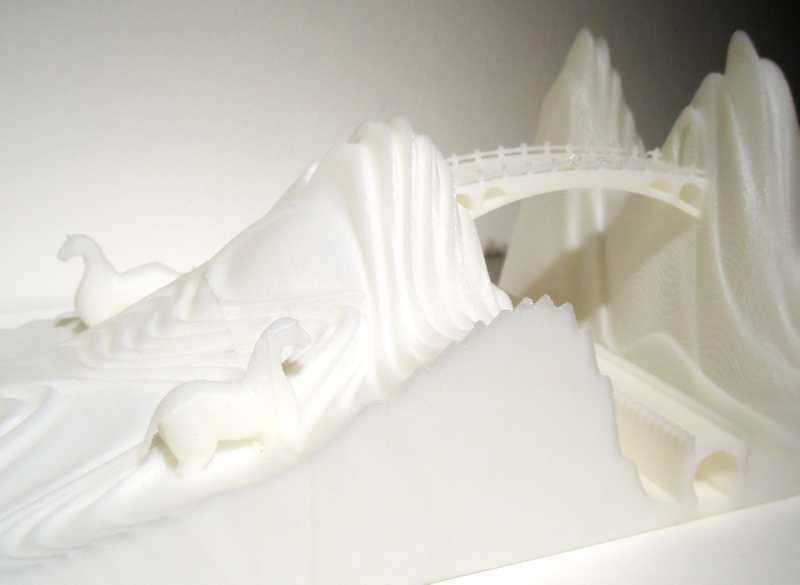
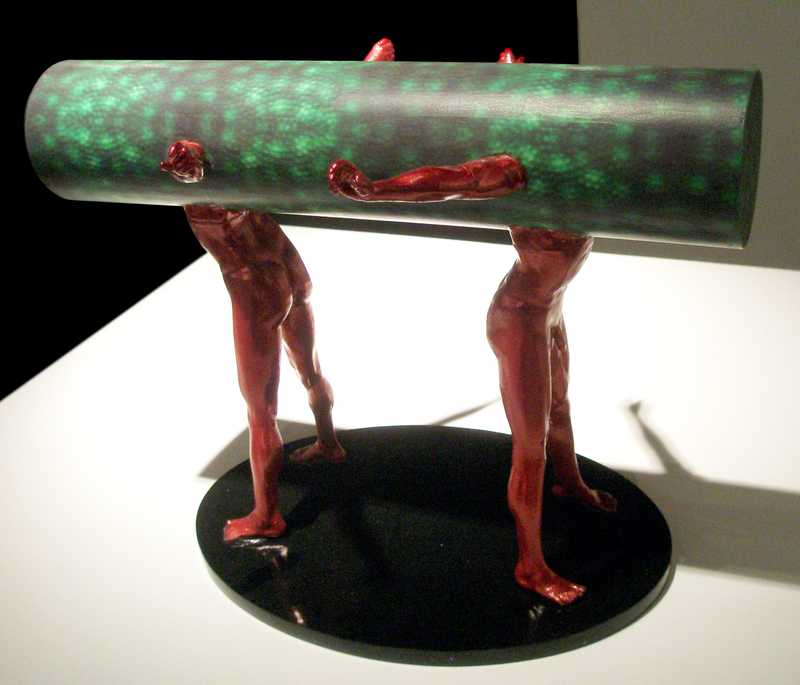
Rees’s “4 Over 4”

Michael Rees, another pioneer of the digital sculpture movement, was represented by several signature pieces that brought to mind a pair of gymnasts who have been working together (and with a horse) for so long that their bodies have merged into one another’s. An animation he provided was helpful in imagining how such a composite might act. Dan Collins, an old friend from the ISC and Siggraph’s Guerilla Studio, presented self portraits based on manipulated 3D scans, while Keith Brown, one of the UK’s foremost digital sculptors, sent in an interesting openwork piece that exploited the ability of the additive 3D printer to produce geometries of great complexity as easily as it builds something solid and simple.
Barry X Ball, Jon Monaghan, Greg Lock, David Morris, Andrew Werby
There were also some people represented here whose work I hadn’t encountered before. Barry X Ball’s “Screaming Portrait of Matthew Barney” pursues the artist’s seeming obsession with the autour of the “Cremaster” cycle to the point of outrage—the subject seeming to object rather strenuously to being flayed, eviscerated, and nailed to a board for display.
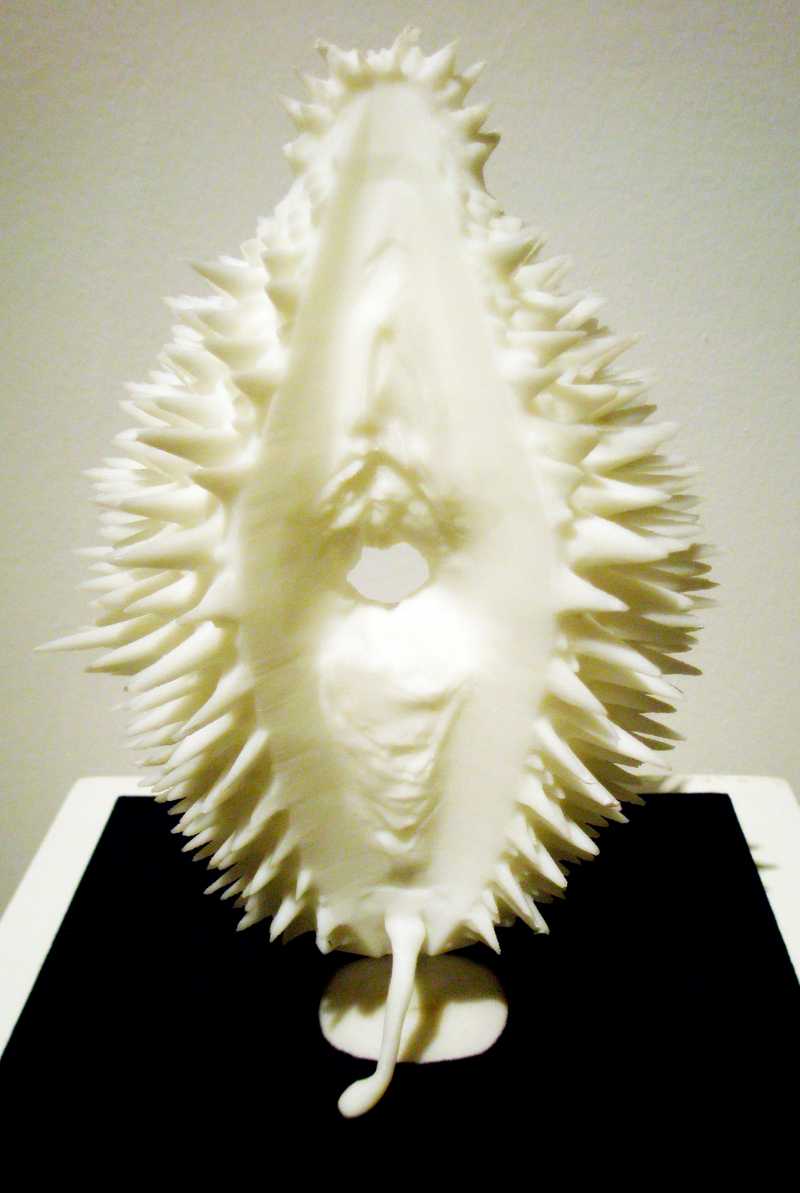
Monaghan’s “Jesus, Jesus Christ”
Jon Monaghan’s “Monstrance” is an interesting take on that sunburst-shaped article of Eucharistic adoration, resembling a prickly sea cucumber or a mutant (monster?) hedgehog. He also produced an animation called “Jesus, Jesus Christ” which also featured an animate object verging on creaturehood, which seemed to be suffering as it writhed on the screen, although perhaps more from peristaltic blockage than the sins of Mankind.
Greg Lock, an artist who likes to toy with the elusive line between analog and digital reality, used a scanner to create a highly pixelated version of an actual log, then replicated it in a way that rendered each pixel as a rectangular element, which he painted by hand in different colors. David Morris, who has been working with digital media for some time, sent in “Matador’s Cape” a simple but handsome piece in black ABS plastic which used the artifacts of the digital printing process to add detail without distracting from the form.

I could go on listing art and artists—there were more here, including myself—I contributed a couple of pieces combining various natural forms with integral photo-textures which I built on a color 3D printer from Z-corp—but if you’ve read this far you deserve a break. Suffice it to say that this was a great show giving an excellent view of what’s happening currently in the world of digital sculpture. As I write this, the Shanghai show is about to close, but it’s traveling to Chongqing next, where it will be at the Jinse Gallery there until the middle of January 2009. My hat goes off to the organizers, especially Robert Smith, who worked his butt off collecting, creating, and building the art, dealing with artists, officials, and media, as well as to the presenters and sponsors who made it all possible.
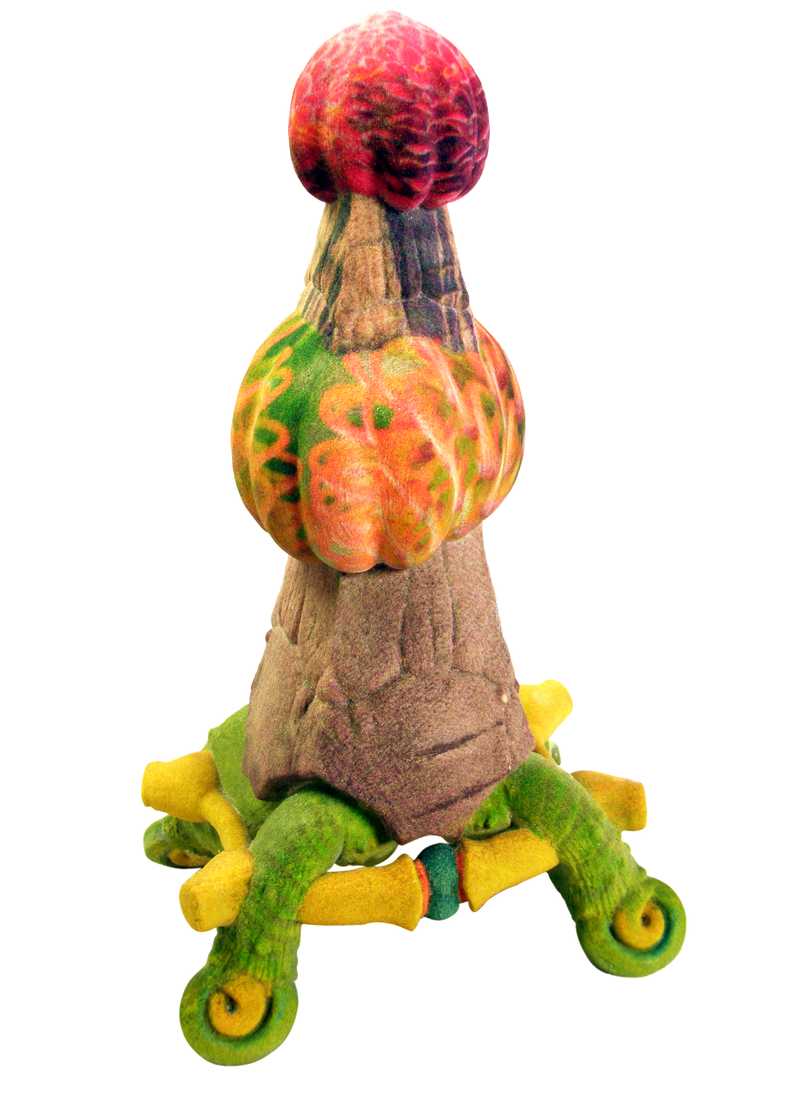
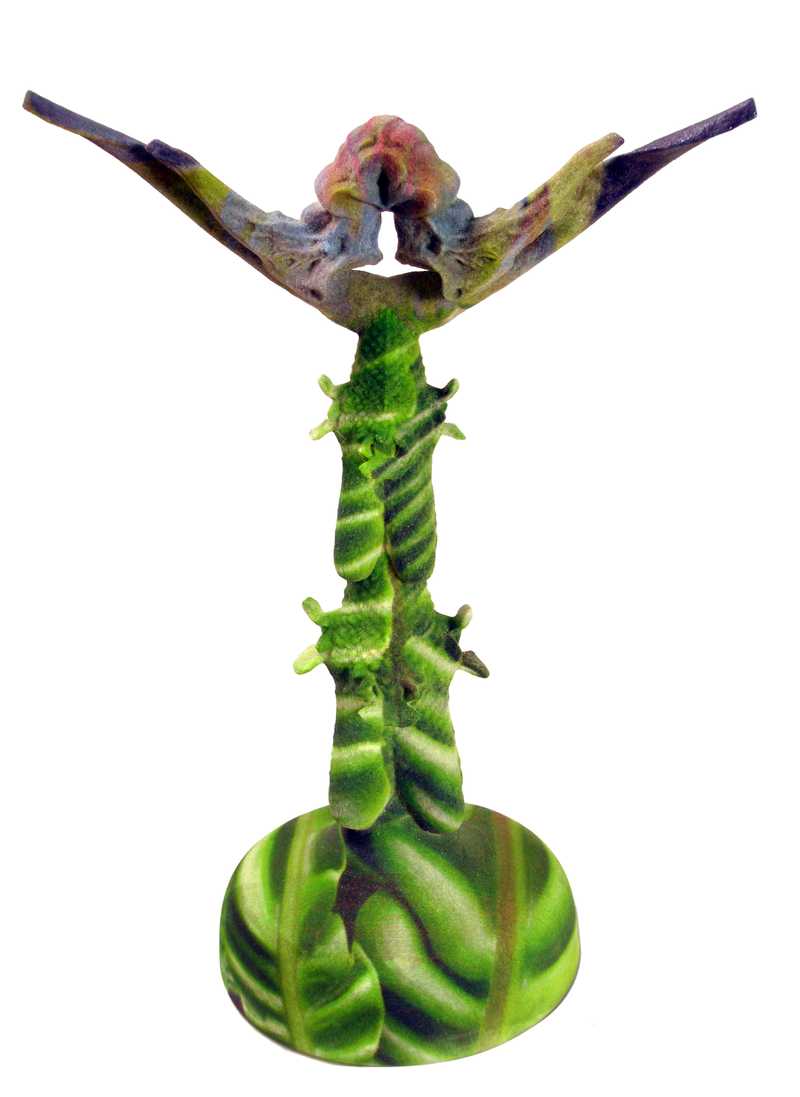
Works by Andrew Werby
Andrew Werby